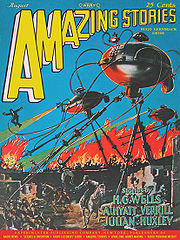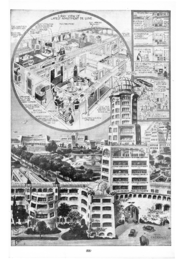
Frank R. Paul
Encyclopedia

Pulp magazine
Pulp magazines , also collectively known as pulp fiction, refers to inexpensive fiction magazines published from 1896 through the 1950s. The typical pulp magazine was seven inches wide by ten inches high, half an inch thick, and 128 pages long...
s in the science fiction
Science fiction
Science fiction is a genre of fiction dealing with imaginary but more or less plausible content such as future settings, futuristic science and technology, space travel, aliens, and paranormal abilities...
field. He was born in Vienna
Vienna
Vienna is the capital and largest city of the Republic of Austria and one of the nine states of Austria. Vienna is Austria's primary city, with a population of about 1.723 million , and is by far the largest city in Austria, as well as its cultural, economic, and political centre...
, Austria
Austria
Austria , officially the Republic of Austria , is a landlocked country of roughly 8.4 million people in Central Europe. It is bordered by the Czech Republic and Germany to the north, Slovakia and Hungary to the east, Slovenia and Italy to the south, and Switzerland and Liechtenstein to the...
and died at his home in Teaneck, New Jersey
Teaneck, New Jersey
Teaneck is a township in Bergen County, New Jersey, and a suburb in the New York metropolitan area. As of the 2010 United States Census, the township population was 39,776, making it the second-most populous among the 70 municipalities in Bergen County....
.
A discovery of Hugo Gernsback
Hugo Gernsback
Hugo Gernsback , born Hugo Gernsbacher, was a Luxembourgian American inventor, writer, editor, and magazine publisher, best remembered for publications that included the first science fiction magazine. His contributions to the genre as publisher were so significant that, along with H. G...
(himself an immigrant from Luxembourg
Luxembourg
Luxembourg , officially the Grand Duchy of Luxembourg , is a landlocked country in western Europe, bordered by Belgium, France, and Germany. It has two principal regions: the Oesling in the North as part of the Ardennes massif, and the Gutland in the south...
), Frank R. Paul was influential in defining what both cover art and interior illustrations in the nascent science fiction pulps of the 1920s looked like.
Work
Paul's work is characterized by dramatic compositions (often involving enormous machines, robots or spaceships), bright or even garish colors, and a limited ability to depict human faces, especially the female ones. His early architectural training is also evident in his work.Among his credits, Paul painted 38 covers for Amazing Stories from April 1926 to June 1929 and 7 for the Amazing Stories Annual and Quarterly; with several dozen additional issues featuring his art on the back cover (May 1939 to July 1946), and several issues from April 1961 to September 1968 featuring new or reproduced art. After Gernsback lost control
Experimenter Publishing bankruptcy
Experimenter Publishing was an American media company founded by Hugo Gernsback in 1915. The first magazine was The Electrical Experimenter and the most notable magazines were Radio News and Amazing Stories . Their radio station, WRNY, began broadcasting experimental television in 1928...
of Amazing Stories in 1929, Paul followed him to the magazines Air Wonder Stories, Science Wonder Stories, and Wonder Stories
Wonder Stories
Wonder Stories was an early American science fiction magazine which was published under several titles from 1929 to 1955. It was founded by Hugo Gernsback in 1929 after he had lost control of his first science fiction magazine, Amazing Stories, when his media company Experimenter Publishing went...
and the associated quarterlies, which published 103 of his color covers from June 1929 to April 1936. Paul also painted covers for Planet Stories
Planet Stories
Planet Stories was an American pulp science fiction magazine, published by Fiction House between 1939 and 1955. It featured interplanetary adventures, both in space and on other planets, and was initially focused on a young readership. Malcolm Reiss was editor or editor-in-chief for all of its 71...
, Superworld Comics, Science Fiction
Science fiction
Science fiction is a genre of fiction dealing with imaginary but more or less plausible content such as future settings, futuristic science and technology, space travel, aliens, and paranormal abilities...
magazine, and the first issue (October–November, 1939) of Marvel Comics
Marvel Comics
Marvel Worldwide, Inc., commonly referred to as Marvel Comics and formerly Marvel Publishing, Inc. and Marvel Comics Group, is an American company that publishes comic books and related media...
. This last item featured the debuts of Human Torch
Human Torch
The Human Torch is a fictional character and superhero appearing in comic books published by Marvel Comics. Created by writer Stan Lee and artist Jack Kirby, he is a member of the superhero team the Fantastic Four, debuting in The Fantastic Four #1...
and Sub-Mariner, and good copies sell at auction for twenty to thirty thousand dollars. All totaled, his magazine covers exceed 220.
His most famous Amazing Stories cover is probably that from August 1927, illustrating a reprint of H. G. Wells
H. G. Wells
Herbert George Wells was an English author, now best known for his work in the science fiction genre. He was also a prolific writer in many other genres, including contemporary novels, history, politics and social commentary, even writing text books and rules for war games...
' The War of the Worlds.
Influence on the Genre
In many ways, Frank R. Paul's achievements and influence on the field through the ages cannot be overestimated. His work appeared on the cover of the first issue (April 1926) of Amazing StoriesAmazing Stories
Amazing Stories was an American science fiction magazine launched in April 1926 by Hugo Gernsback's Experimenter Publishing. It was the first magazine devoted solely to science fiction...
magazine, the first magazine dedicated to science fiction. He would paint all the covers for over three years. These visions of robots, spaceships, and aliens were presented to an America wherein most people did not even own a telephone. Indeed, they were the first science fiction images seen by Ray Bradbury
Ray Bradbury
Ray Douglas Bradbury is an American fantasy, horror, science fiction, and mystery writer. Best known for his dystopian novel Fahrenheit 451 and for the science fiction stories gathered together as The Martian Chronicles and The Illustrated Man , Bradbury is one of the most celebrated among 20th...
, Arthur C. Clarke
Arthur C. Clarke
Sir Arthur Charles Clarke, CBE, FRAS was a British science fiction author, inventor, and futurist, famous for his short stories and novels, among them 2001: A Space Odyssey, and as a host and commentator in the British television series Mysterious World. For many years, Robert A. Heinlein,...
, Forrest J Ackerman
Forrest J Ackerman
Forrest J Ackerman was an American collector of science fiction books and movie memorabilia and a science fiction fan...
and others who would go on to great prominence in the field.
Firsts

Flying saucer
A flying saucer is a type of unidentified flying object sometimes believed to be of alien origin with a disc or saucer-shaped body, usually described as silver or metallic, occasionally reported as covered with running lights or surrounded with a glowing light, hovering or moving rapidly either...
. This painting appeared almost two decades before the sightings of mysterious flying objects by Kenneth Arnold
Kenneth Arnold
Kenneth A. Arnold was an American aviator and businessman. He is best-known for making what is generally considered the first widely reported unidentified flying object sighting in the United States, after claiming to have seen nine unusual objects flying in a chain near Mount Rainier, Washington...
. So large was his stature that he was the only guest of honor at the first World Science Fiction Convention in 1939. He has been described as the first person to make a living drawing spaceships; this is a slight exaggeration, as much of his income was also derived from technical drawing.
He was also the cover artist of Marvel Comics
Marvel Mystery Comics
Marvel Mystery Comics is an American comic book series published during the 1930s-1940s period known to fans and historians as the Golden Age of Comic Books...
#1 (Oct. 1939), the first ever Marvel Comic.

